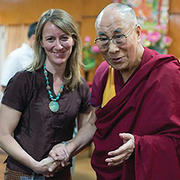
Steven Simon’s warning in the January 4, 2000, edition of the New York Times was like cold water in the face of Americans still bleary-eyed from partying like it was 1999. Simon, fresh from a counterterrorism assignment in the Clinton White House, and his National Security Council colleague Daniel Benjamin wrote of a new combination of “religious motivation and the desire to inflict catastrophic damage,” among extremists in the Middle East. This movement, they predicted, would only “grow and persist” even if its then little-known leader Osama bin Laden were arrested immediately. When Simon and Benjamin’s words proved prophetic on September 11, 2001, it illustrated the importance of religious knowledge—and the consequences of its absence—in national security and foreign policy circles.
“Social science tended to derogate or deride the importance of religion,” he says. “People in government just didn’t think in those terms.” Simon, MTS ’77, is part of a group of Harvard Divinity School alumni helping to shape U.S. diplomacy and foreign policy at the highest levels. These graduates— who also include the first female director of religion and peacebuilding at the U.S. Institute of Peace and the first United States permanent representative to the United Nations Human Rights Council—carry with them a deep understanding of the world’s major traditions and a commitment to ethics and justice. Together, they are forging a new approach to international relations that acknowledges the central role of religion.
Confronting the New Face of Terror
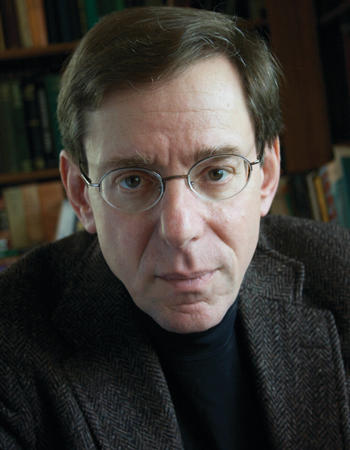 Simon came to the U.S. Department of State and then the White House at a time when modernization and secularization theory were still the dominant ways of understanding the Middle East. These held that religion was obsolete and that the “new Middle Eastern man”—technocratic, military, left-leaning—would lead his country to secularism and economic development. On academic leave at Oxford after the first Gulf War, Simon studied Salafist literature and considered its implications for Middle Eastern politics.
Simon came to the U.S. Department of State and then the White House at a time when modernization and secularization theory were still the dominant ways of understanding the Middle East. These held that religion was obsolete and that the “new Middle Eastern man”—technocratic, military, left-leaning—would lead his country to secularism and economic development. On academic leave at Oxford after the first Gulf War, Simon studied Salafist literature and considered its implications for Middle Eastern politics.
The Islamic revivalism of the late twentieth century made it difficult for analysts to ignore religion as a force shaping popular consciousness throughout the region. Simon says that his HDS experience put him at the vanguard of a new group of diplomats looking to integrate an understanding of religion into U.S. foreign policy.
“After the Oklahoma City bombing in 1995, the Clinton administration decided that they needed to have somebody working full time on counterterrorism,” Simon explains. “They pulled me by the collar and put me in that job. I and certain colleagues in the CIA were very tuned in to the evolving role of religion in Middle Eastern politics. I was sensitized to it precisely because of my background at HDS. That’s 100 percent the reason.”
As senior director of transnational threats at the National Security Council, Simon took note of troubling developments in the Middle East. Authoritarian regimes repressed political speech, only to see it go underground and resurface as religious expression.
“There was a revival of Islam, which really took off as the previous model of development began to show its bankruptcy,” he says. “The mosque became the only place to express dissent because these regimes were all very repressive, for the sake of survival. Osama bin Laden was an exemplar of this sort of revivalism.”
Simon left the administration in 1999, but sought to return to service after the September 11 attacks. Unfortunately, the partisan divide in Washington left no place for someone who had served in a Democratic White House. Simon became the deputy director of the International Institute for Strategic Studies in London, where he sought to exert influence through his writing and scholarship. He collaborated again with Daniel Benjamin on The Age of Sacred Terror, which traced the roots of Salafi jihadism back to medieval times. The book won the 2004 Arthur Ross Award from the Council on Foreign Relations (CFR)
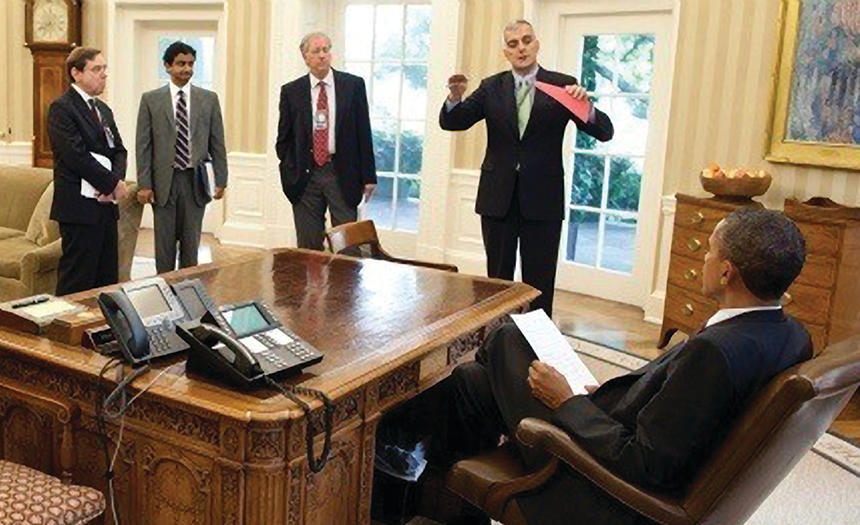
From left: Simon, Prem Kumar, Dennis Ross, Denis Mcdonough, Obama
After stints at the CFR and the RAND Corporation, Simon got the call from the White House once more in the early years of the Obama administration. His second tour on the National Security Council came at a time of profound change. As the staffer in charge of North Africa and the Middle East, Simon dealt with the revolutions of the Arab Spring, military intervention in Syria, the U.S. troop withdrawal from Iraq, and crises between Turkey and Israel. Always in the background of all were negotiations on what would ecome the administration’s most significant foreign policy achievement: a nuclear deal with Iran.
“The security cabinet meets all the time, so you help prepare the national security advisor and the president,” Simon says. “I staffed 40 cabinet meetings on just my countries, and 80 subcabinet meetings in the White House. I traveled with Secretary of Defense Leon Panetta and Secretary of State Clinton and, among other things, staffed President Obama’s weekly calls to [Israeli Prime Minister] Benjamin Netanyahu. It was a whirlwind of activity.”
Simon left the Obama Administration in 2012 to become executive director of the International Institute for Strategic Studies (IISS) Middle East office, then returned to academia. First at Dartmouth and now at Amherst College, he teaches courses on Middle Eastern history, political economy, intelligence, and policy. In June, Simon published Our Separate Ways, a book about one of the most emotionally charged issues in U.S. foreign policy: the U.S.-Israel relationship. In it, he contends that rapid demographic, political, and social changes for both countries have led to the emergence of important strategic differences. To save the relationship, he says it must be “reconsecrated.”
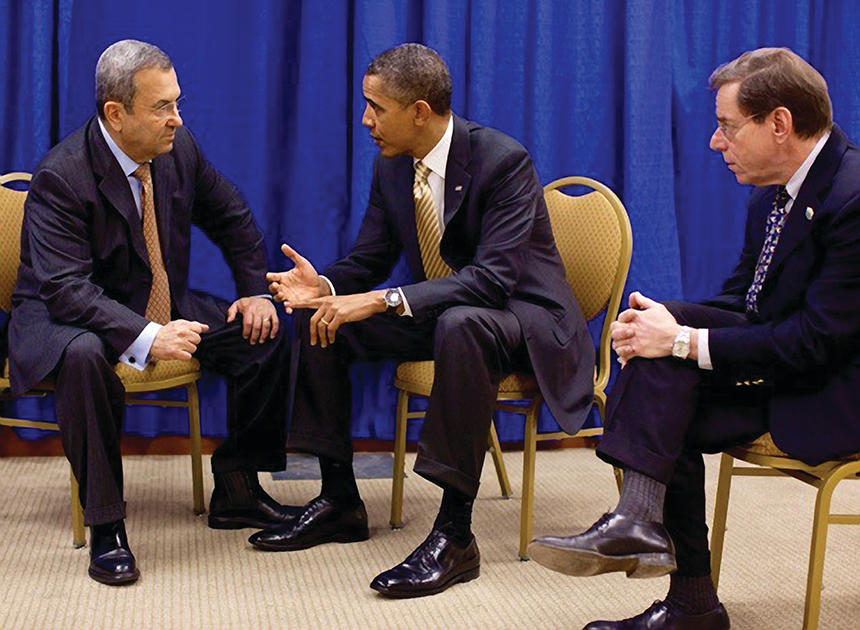
From left: Ehud Barak, Barack Obama, and Steve Simon
“There is, in its origins, a kind of covenant between the United States and Israel,” he says. “It originated in sacrifice, profound on the Jewish side, but there was also the United States, which destroyed Nazi Germany and then facilitated the creation of the State of Israel. If we care about that relationship, then the simple step is to restore it, or as I put it, ‘reconsecrate’ it. Our Separate Ways puts forward some ideas for doing that.”
Simon is now working on a new book, “The Long Goodbye: The United States and Middle East from the Islamic Revolution to the Arab Spring.” He says that there’s been a sea change in the way that those in the Foreign Service think about religion. “At this point, everybody understands the powerfully motivating role of religion,” he says. “That’s really sunk in.” Looking to the future, though, Simon says that it’s critical for policy makers to understand not only the religious overtones of conflict, but also their historical, economic, and political context. Only then can they have a complete picture of the strategic landscape.
“It’s sort of like the Thirty Years’ War,” he says. “Religion was a huge component of that, but at the end of the day, the negotiation wasn’t only about religion. It was about how to deal with each other’s interests, stop fighting, and create a durable peace.”
Divine Disruptor
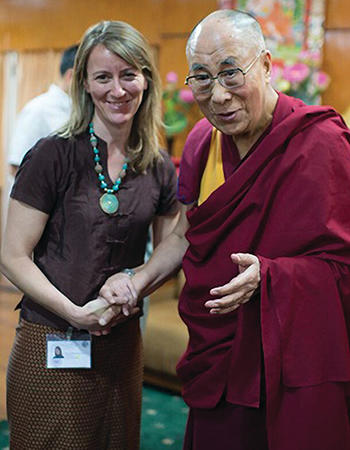 Working for durable peace is more or less Susan Hayward’s job description. Where Simon keeps his eye on the potential for religiously inspired violence, Hayward, MDiv ’07, director of religion and peacebuilding at the United States Institute of Peace (USIP), leverages the power of faith communities to resolve conflict.
Working for durable peace is more or less Susan Hayward’s job description. Where Simon keeps his eye on the potential for religiously inspired violence, Hayward, MDiv ’07, director of religion and peacebuilding at the United States Institute of Peace (USIP), leverages the power of faith communities to resolve conflict.
“Through USIP’s religion and peacebuilding program, we work in active conflict zones around the world, across myriad faith traditions,” she says. “We seek to develop effective processes for engaging religious actors and factors to advance interfaith respect and cooperation, promote human rights, strengthen security and justice, and to address the needs of those living in the midst of violence.”
Established by Congress in 1984, USIP is involved both in research and analysis and in the implementation of peacebuilding efforts around the world. Since 1989, the Institute has had programs exploring the role of religion in conflict and peace. USIP’s first, primarily research-based, religion program was led by former Harvard Divinity School professor David Little. Hayward, the group’s current thematic expert in the area of religion, has partnered with governments and international organizations on field projects in Sri Lanka, Myanmar, Colombia, and Iraq. She begins her work by examining the immense complexity of the forces that influence the situation in any conflict zone.
Hayward arrived in Myanmar, for instance, at a time of massive social, political, and economic transformation. In the wake of the Saffron Revolution, where Buddhist monks took to the streets, the country was transitioning to democracy from nearly 50 years of military rule. The stresses on the society manifested as tension between Buddhists and Muslims. Hayward and her team supported religious actors working to de-escalate the situation and head off outbreaks of violence.
“I went in and got to know how the various religious communities were responding to the peace process and ceasefire negotiations and to the transition from authoritarianism,” she says. “We helped by providing knowledge and strategy about how to do interfaith work in a way that could truly transform the dynamics of conflict, as well as the state structures that impede peace.”
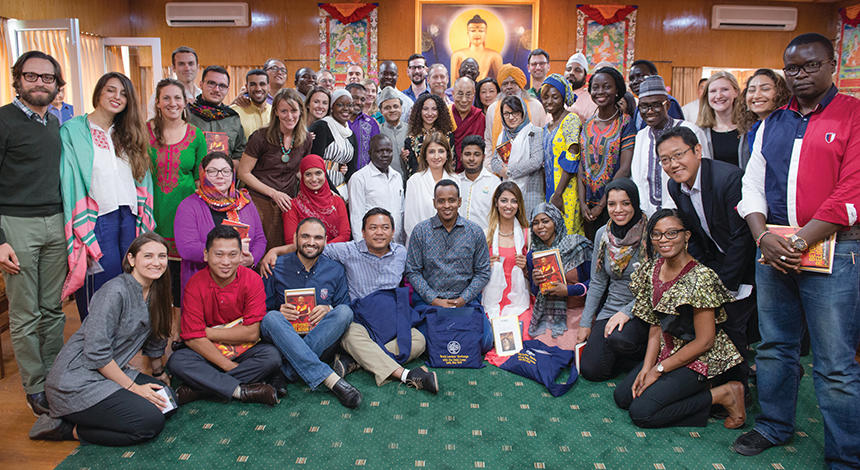
Hayward, who is a minister in the United Church of Christ, says that she chose the ordination path with her current career in mind. At HDS, she was impressed at the way that Christian ministry combined the prophetic voice and pastoral care—both essential to peacemaking.
“There always needs to be a balance between calling out, telling truth to power, and bringing care and love to those who are living in situations of violence,” she says. “I came to fully appreciate my own tradition, Christianity, as kind of the divine disruptor of the world, achieved through this prophetic-pastoral approach.”
Today, as a member of the clergy, Hayward can relate to religious actors as a colleague, rather than as an outsider looking to harness the local faith community to serve political or security interests. Most of all, the ordination path gave her the internal resources to do work that can be frustrating and challenging as often as it is rewarding.
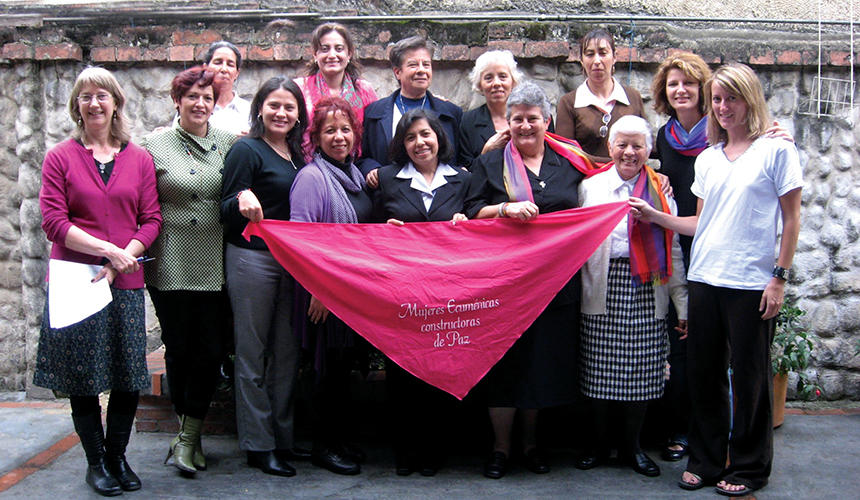
“The deepening and strengthening of my spiritual practices and commitments has not only given me a moral compass, but also internal resilience,” she says. “Most importantly, it’s given me hope that violence doesn’t have the last word, that love overcomes hate, and that putting your faith and your belief in those things is not a weakness, but a strength.”
The Heart of Human Rights
While she didn’t pursue an ordination path, Eileen Chamberlain Donahoe, MTS ’84, shares Susan Hayward’s commitment to ethics and values. She came to the Divinity School to delve deeply into philosophical and moral questions before embarking on what’s become a 30-year career in law, international security and cooperation, human rights, and diplomacy. She says those concerns—and the years she spent at HDS reflecting on them—continue to shape her life and work.
“Those questions about how society is organized . . . about the relationship between government and citizens,” Donahoe said at HDS in 2014, “I’ve carried with me from those days on throughout my career and in everything I’ve done . . . . Even though there is an individualism at the heart of the human rights movement, in many ways, the biggest question is ‘How do governments get to treat their citizens?’”
As the first permanent U.S. representative to the United Nations Human Rights Council from 2010 to 2013, Donahoe worked at the intersection of morality and pragmatic diplomacy. She and her team achieved concrete results on fundamental issues, not by dictating right and wrong to other nations but by asking them to reflect on their own history and values. On the issue of freedom of assembly and association, for instance, Donahoe built support with Argentina by calling to mind the protests of the Mothers of the Plaza de Mayo, whose children had been “disappeared” by the country’s authoritarian regime in the 1970s. For Poland, it was the Solidarity movement. For South Africa, it was antiapartheid.
“If they didn’t have the right to assemble and associate, then those societies would not have been transformed,” Donahoe said. “In each of these cases, you could see the light in the eye of our diplomatic counterparts. They would say, ‘Yes. That’s our value. We own that.’”
At the same time, she and her team struggled with fundamental differences in values between the United States and other nations. She found herself at odds, for instance, with representatives from other cultures who believed it was their moral obligation to oppose equal protection under the law for lesbian, gay, and transgender citizens.
“People would stand up in Palais des Nations room 20 where we did our work in Geneva and feel very certain that they were standing up for truth and justice by not supporting LGBT rights,” she remembers. “The clash of values was just palpable.”
After serving out her term at the United Nations, Donahoe was appointed director of global affairs at Human Rights Watch (HRW), where she represented the organization worldwide on “human rights foreign policy, with special emphasis on digital rights, cybersecurity, and Internet governance.” One of her top priorities has been narrowing the “digital divide” between the 65 percent of the developing world that has no access to the internet and their online counterparts.
“While those of us who live in the digital ecosystem can’t remember what daily life is like without Internet connectivity or our digital devices,” she wrote on the Human Rights Watch site in March 2016, “the majority of people in the world have zero digital experience . . . . These digital divides have the potential to significantly exacerbate existing global inequality and lead to conditions where conflict is more likely.”
Whether at the UN or HRW, Donahoe says that her work has been animated by a personal commitment to care, service, and justice that “comes from a place that has a spiritual and religious dynamic.” She appeals to that same energy in others in her efforts to resolve conflict, build consensus, and advance human rights around the world.
“There’s such resonance in that idea of getting people to step back and claim their values,” she says. “People are animated by things other than the intellect. At the end of the day, truth can only be told on some level in ways that are different than linear analytic thinking. Whether it’s literature, spirituality, or mysticism, that’s where the truth is. That’s what really animates people around the world.”
—Paul Massari
